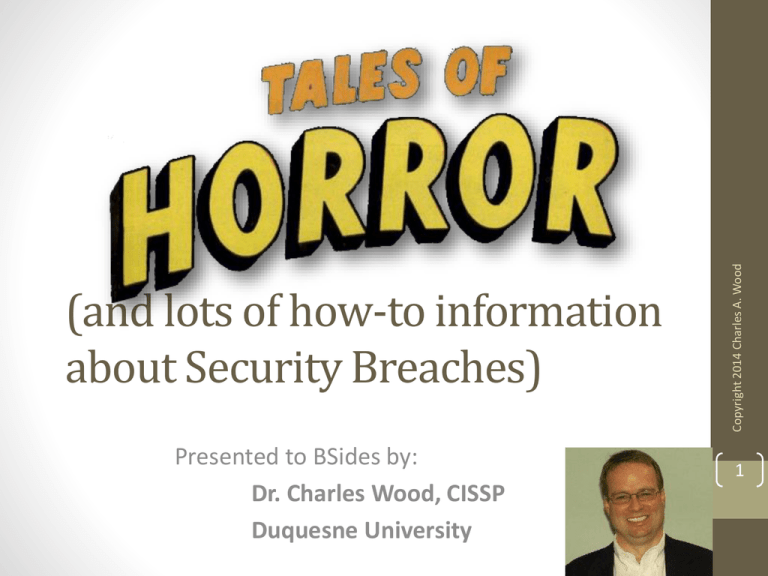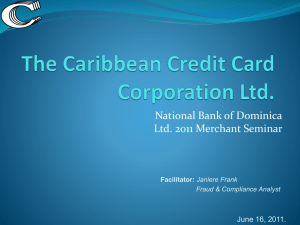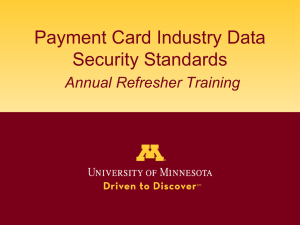Presentation
advertisement

Presented to BSides by: Dr. Charles Wood, CISSP Duquesne University Copyright 2014 Charles A. Wood (and lots of how-to information about Security Breaches) 1 Compliance that Drives Information Systems Security Health Insurance Portability and Accountability Act (HIPAA) Sarbanes-Oxley Industry Credit cards and PCI Copyright 2014 Charles A. Wood Government 2 About Me… • • • • • Who I am not • I do not practice law, and this is not legal advice(!) Information Security • Seek legal advice from a lawyer Risk Management • I do not audit (that much, anyway) IT Infrastructure • You probably need a CISA, not a CISSP, Software Development for auditing Currently at Duquesne University • I’ll admit, sometimes, the line is a little (4 years) blurry between securing (which I do) and • Notre Dame (9 years) auditing (which I don’t do – that much). • University of Minnesota (4 years) • I do not accredit • IT Consultant (over 25 years) • Degrees and certifications • CISSP • Probably the premier security certification • • • • Ph.D. in Information Systems MBA Computer Science B.S. Finance B.S. • You need to have your systems accredited (usually internally by management) • You can train someone to help with this as well! • I do not certify Copyright 2014 Charles A. Wood Who I am • Professor teaching • You need to have your systems certified by an recognized (external?) source And the CEO of ShiftSecure. (REALLY wish I had something to sell you!) 3 Credit card Breach Announcements January 2014 • Went from 40 million cards hacked to 70 million on 1/13 to 130 million today • If you shopped from late November to early December, be careful! • May have been storing 3-digit CVV codes. (Bad!) • How else do you steal a credit card? • Attack used malware called a “RAM Scraper” called POSRAM: • Uploads used but not cleared memory to the hacker • Infects POS systems • More sophisticated than seen before • Waited a month before first hearing about it and telling customers • Waited two weeks before conclusive proof existed and telling customers • Ongoing Investigation • Not fixed yet • Answers could take weeks • Investigator hints at a RAM Scraper, like Target 3 other undisclosed breaches (hints of Eastern European retailers, which makes sense) Copyright 2014 Charles A. Wood Target 4 • • • • • • • Target and Neiman Marcus A massive increase in bad card availability – 10x - 20x, on December 11. 2 million bad credit cards were dumped into the market on January 4. Congress may get involved, on top of Visa involvement. Senate banking committee is examining this issue in the coming weeks. InfoWeek reports that investigators say that at least three other as-yetunnamed retailers were successfully breached at the end of 2013 by the same gang!!! Strong overlap in time between the two breaches Attacks were preceded by a series of smaller attacks that began a few months before the post-Thanksgiving shopping rush. Timing may suggest that the attacks occurred where the stores were unwilling to get the bad press by immediately notifying customers. (Christmas rush.) Want more 2014 breaches? Check out Verizon’s report: http://www.verizonenterprise.com/DBIR/2014/ Copyright 2014 Charles A. Wood Credit card Breach Announcements 1/13/2014 5 • Security blogger • Target only acknowledged its 2013 attack after Krebs reported the breach. • Neiman Marcus disclosed the 20132014 breach nine days after an inquiry from Krebs OK, he’s Superman, for now. Here’s his link: http://krebsonsecurity.com/ Copyright 2014 Charles A. Wood SIDEBAR: Who is Brian Krebs? 6 Get the max for the minimum… • $9.75 million to 41 states. (Ouch!) • Ignored evidence for years! • Get this! PCI DSS • PCI DSS decided they weren’t complaint • After they certified by PCI DSS • And then fined them into oblivion! • (Get the max for the minimum, am I right?) Copyright 2014 Charles A. Wood • The (previous) largest Visa hack ever! 7 • The Payment Card Industry (PCI) has developed a Data Security Standard (DSS) • Considered Ultra-Secure • No one has ever hacked into a PCI DSS compliant company before! • BUT TJ Maxx / TJX was considered compliant, but had their compliancy retroactively revoked after a hack in 2007. • PCI claimed that they misrepresented their DSS compliance • This may happen to Target and Neiman with the CVV problem. • If you are hacked, you automatically are no longer considered PCI compliant until you fix what was wrong • Results in large, large, LARGE fines and possible refusal to accept credit card transactions! Copyright 2014 Charles A. Wood Target, Neiman, and TJMaxx were PCI DSS Compliant! (at one time) 8 • Anonymous and LulzSec (group out of Arizona) hacked into Sony in 2011 • Shut down business for a month • With … an SQL Injection attack … I mean, seriously, Sony … an SQL injection! • Ludicrously bad. Sony didn’t even know what was stolen for months! • Sony said the breach ultimately cost the company more than $600,000. • (Yeah, right. $600,000.) Copyright 2014 Charles A. Wood Injection attack at 9 1. Use and maintain firewalls 2. Reset vendor password defaults 3. Protect cardholder data at rest (!) 4. Encrypt transmitted cardholder data 5. Use & update antivirus software 6. Systems and Applications must be developed with security in mind (!) 7. Cardholder data only available by “need to know” 8. Access controls with unique user ID 9. Physical access to data must be restricted 10. Network and data access must be tracked 11. Security systems must be regularly tested (!) 12. Policies in place that address information security (!) Available at https://www.pcisecuritystandards.org/documents/PCI_DSS_v3.pdf 3.0 update available since November 2013 Copyright 2014 Charles A. Wood PCI DSS – 12 Requirements 10 Potential PCI DSS cost of a security breach • Fines of $500,000 per incident for being PCI non-compliant • Fines of $50,000 per day for non-compliance with published standards • • • • • • • • • Liability for all fraud losses incurred from compromised account numbers Liability for the cost of re-issuing cards associated with the compromise Suspension of merchant accounts Increased audit requirements from PCI Potential for enterprise-wide shut down of credit card activity by the merchant bank (This is bad … very bad!) Cost of printing and postage for customer notification mailing Cost of staff time (payroll) during security recovery Cost of lost business during register or store closures and processing time Decreased sales due to marred public image and loss of customer confidence Copyright 2014 Charles A. Wood • Can be retroactive if misrepresentation / fraud exists 11 What PCI data can be stored… • Can store in database • Consists of: • Primary Account Number (PAN) • Cardholder Name • Expiration Date • Service Code (code that designates where the card is used (and for what) changes on the contactless interface) Sensitive Data • Cannot store in database (unless there is a business justification) • Consists of: • Full track data (data on the magnetic strip or on a chip) • CAV2/CVC2/CVV2/CID (that three digit number on the back) • PINs (or PIN blocks) Copyright 2014 Charles A. Wood Encrypted (!) Cardholder Data 12 OK, so PCI DSS can be hacked?... • Also known as EMV • Stands for Europay, MasterCard, and Visa • Refers to their global standard for integrated circuit chips built into cards • Requires a smart (ish) card with a PIN • No purchases can be made without both • Maybe a password has never been enough • Starting 10/2012, vendors are exempt from validating PCI DSS (!!!) if with 75% of their purchases from EMV • Starting 10/2017, fuel vendors use this, or liability is transferred to their bank! Dissent from PCI DSS • DSS Never took off • 67% never comply • Since 2009, credit card fraud is +62%. • Andrea Barisani of Inverse Path showed how “Tamper Proof” EMV cards can be hacked • From a chip-skimmer found in the wild • Blocked by Netherlands upgrade • Hacked entities are “retroactively” denied DSS compliance • PCI is designed to push nearly all risks and costs onto merchants and their banks through a series of contracts Copyright 2014 Charles A. Wood PIN and Chip 13 Myths of PCI Compliance 1. One vendor is all it takes • Several vendors, on-site staff, training, policies, etc. • 80% of the hacks are social engineering with company employees Outsourcing makes us compliant • But it does help! 3. This isn’t for the “big picture” people • Management-wide training, adherence, policy 4. PCI compliance means we are secure • Can anyone say “Target”? 5. PCI is too much work • Aren’t you doing it anyway? • Shouldn’t you be doing it anyway? 6. We only take a few credit cards • And yet your liability is unlimited Copyright 2014 Charles A. Wood 2. 14 • The Health Insurance Portability and Accountability Act (HIPAA) is federal legislation which addresses issues ranging from health insurance coverage to national standard identifiers for healthcare providers. • Regulations dealing with Protected Health Information or PHI. : • PHI privacy • PHI security • Regulations that deal with civil rights • The rights to your own health information • The right to privacy Copyright 2014 Charles A. Wood What is HIPPA? 15 Preventable HIPAA Breaches • Disgruntled employee downloaded medical records: • DeCaprio, Barrymore, Schwarzenegger, Hanks • Supervisors, Co-workers • No privacy training • No employee sanctions for bad behavior • Limited access controls • Fines: $865,500 • Simple access control and training would have stopped this Copyright 2014 Charles A. Wood UCLA Health System • Breaches in 2005-2008 16 Preventable HIPAA Breaches • Over 10,000 medical records had been “imaged” during the copying process. • Disk drive stored the images • 60% of Sharp survey respondents didn’t know that hard drives were in printers • 334,000 individuals were affected • Fined $1.2 Million (!!!) • Procedures to remove or erase hard drives would have resolved this Copyright 2014 Charles A. Wood Affinity Health Care • Affinity Health Care sold a printer 17 Phoenix Cardiac Surgery • In 2012, doctors used an Internet-based calendar to list patient surgical appointments • Easily accessed • Paid a $100,000 fine • Training and awareness would have stopped this Copyright 2014 Charles A. Wood Preventable HIPAA Breaches 18 Preventable HIPAA Breaches Cignet Health of Maryland • Cignet ignored HHS’s Office of Civil Rights to produce records. • Cignet made no attempt to resolve the issue with the 41 patients. • A court said that allegations make this an instance of willful neglect to comply with HIPAA’s privacy rule • Added $3 Million to the fine (!!!) Copyright 2014 Charles A. Wood • $1.3 Million fine for not providing 41 patients with their health recs. • It was raised to $4.3 million because (allegedly) • Procedures needed to: • Quickly respond to record requests • Cooperate with authorities 19 From http://www.healthleadersmedia.com/content/TEC-262931/Cignet-Health-Fined-43M-for-HIPPA-Violations What Federal Penalties Are Imposed if You Violate HIPAA • Tier A: Unintentional & would have handled differently: – Min per violation: $100 – Max per year: $25,000 • Tier B: Violations due to reasonable cause, but not willful neglect: – Min per violation: $1,000 – Max per year: $50,000 • Tier C: Willful neglect that organization corrected: – Min per violation: $10,000 – Max per year: $250,000 The Fed Jurisdiction • HHS required to investigate and impose civil penalties where violations are due to willful neglect • Feds have 6 years to initiate civil penalty action • State attorneys general can pursue civil cases against HIPPA violators • Civil penalties now apply to business associates • Tier D: Willful neglect that organization did not correct – Min per violation: $50,000 – Max per year: $1.5 Million Each person named can be considered a separate violation!!! So can business associates (like a hosting company, for instance)!!! Copyright 2014 Charles A. Wood Four Tiers 20 HIPAA Violations by Year 250 212 200 181 200 150 100 52 50 1 1 0 Copyright 2014 Charles A. Wood 159 21 For spanning violations, the date of the last violation is used. From http://www.hhs.gov/ocr/privacy/hipaa/administrative/breachnotificationrule/breachtool.html HIPAA Violations by Type 402 167 100 43 50 33 11 Copyright 2014 Charles A. Wood 450 400 350 300 250 200 150 100 50 0 22 HIPAA Violations by Device 190 98 96 96 60 37 24 7 5 Copyright 2014 Charles A. Wood 200 180 160 140 120 100 80 60 40 20 0 193 23 First Enron (and Tyco, and WorldCom, and Adelphia, and Anderson, and Peregrine, and …) Then SOX • U.S. Senator Paul Sarbanes (D-MD) • U.S. Representative Michael G. Oxley (R-OH) • Top management must now individually certify the accuracy of financial information. • Penalties for fraudulent financial activity are much more severe. • Auditors are no longer allowed to have other contractual agreements with auditing client • Increased the oversight role of boards of directors. Copyright 2014 Charles A. Wood • Rampant fraud, misrepresentation, etc., within a few firms and (a single?) account auditing firm(s?) as well led to SOX • Sarbanes-Oxley, A.K.A., SOX, is named after congressional sponsors 24 11 Major Elements of SOX • Civil penalties defined • Title IV – Enhanced Financial Disclosures • Title V – Analyst Conflicts of Interest • Title VI – Commission Resources and Authority • Title VII – SEC Studies and Reports • Title VIII – Corporate and Criminal Fraud Accountability (!) • Criminal penalties for manipulation, destruction or alteration of records • Protections for whistle-blowers. • Title IX – White Collar Crime Penalty Enhancement (!) • Failure to certify corporate financial reports is a criminal offense! • Title X – Corporate Tax Returns • CEO has to sign, and thus certify! • Title XI – Corporate Fraud Accountability • Corporate fraud and records tampering as criminal offenses Copyright 2014 Charles A. Wood • Title I – Public Company Accounting Oversight Board (PCAOB) • Title II – Auditor Independence • Title III – Corporate Responsibility (!) 25 Pros vs. Cons • • • • 200 companies Avg revenue of $6.8 Billion Avg cost of $2.9 Million Down 23% from 2005 • 2007 survey: • 168 companies • Avg revenue of $4.7 Billion • Avg cost of $1.7 Million • SOX Compliance costs continue to decrease with respect to revenue, which is good • No one gets out for less than $15 K (or so I’ve heard) Benefits (from research) • SOX firms have become more transparent • Eventual higher stock prices because of reduced risk? • Perceived to be more reliable • Earnings reports are now more conservative • 10% increase in stock price between on-time compliance and late compliance • Exceeds the cost of compliance • 50 to 150 loan basis point reduction because of controls Copyright 2014 Charles A. Wood Compliance Costs • 2006 survey: 26 • You will get hacked! (It’s just a question of when.) • It’s not a geek’s job! (It’s an enterprise-wide initiative.) • Any Questions? • Any Comments? • How does your organization ensure compliance? • We all love stories! Thank you! Copyright 2014 Charles A. Wood So … Any thoughts? 27








